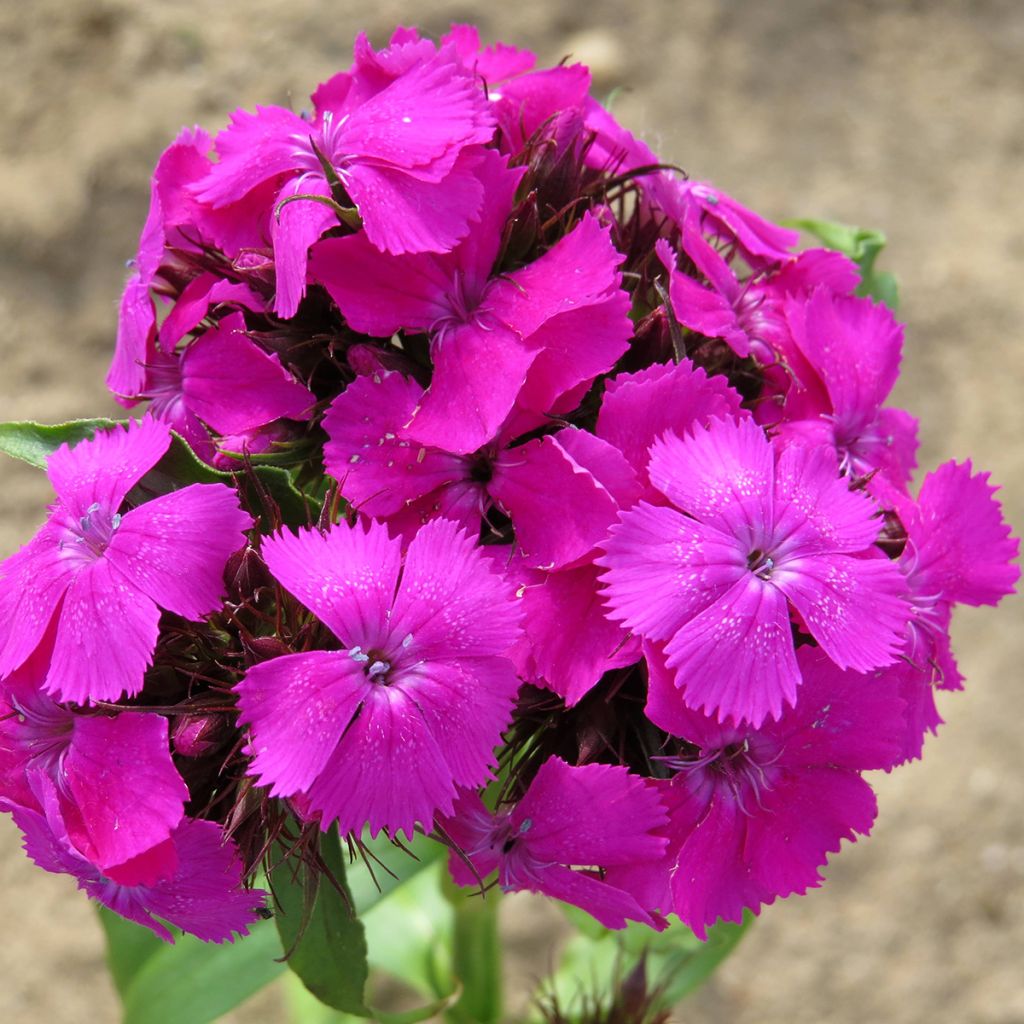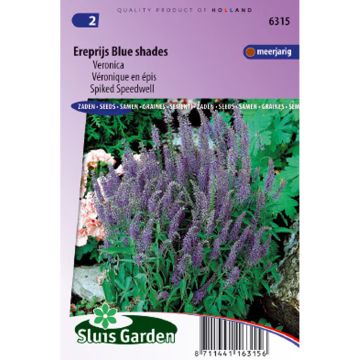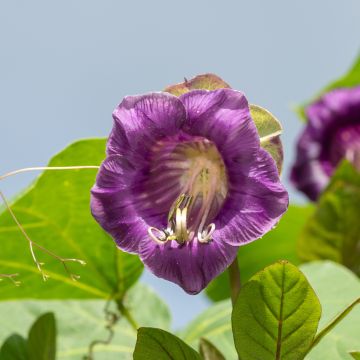Sweet William or Dianthus barbatus 'Etournelle Lilac' Seeds allow you to easily grow this ornamental biennial, prized for its umbels of small lilac flowers with subtle shades and a light fragrance. This upright and bushy variety illuminates flower beds, borders and planters with its generous flowering. Its light green, finely cut foliage contrasts elegantly with the softness of its flowers. Easy to grow in rich, moist and well-drained soil, it tolerates cold well and enjoys sunny exposures.


Sweet William Etournelle Lilac seeds - Dianthus barbatus
Share your pictures?
Hide split images
New arrival
Sweet William Etournelle Lilac seeds - Dianthus barbatus
Dianthus barbatus Etournelle Lilac
Sweet William
Be the first to leave a review
Special offer!
Receive a €20 voucher for any order over €90 (excluding delivery costs, credit notes, and plastic-free options)!
1- Add your favorite plants to your cart.
2- Once you have reached €90, confirm your order (you can even choose the delivery date!).
3- As soon as your order is shipped, you will receive an email containing your voucher code, valid for 3 months (90 days).
Your voucher is unique and can only be used once, for any order with a minimum value of €20, excluding delivery costs.
Can be combined with other current offers, non-divisible and non-refundable.
Home or relay delivery (depending on size and destination)
Schedule delivery date,
and select date in basket
This plant carries a 6 months recovery warranty
More information
We guarantee the quality of our plants for a full growing cycle, and will replace at our expense any plant that fails to recover under normal climatic and planting conditions.
A biennial variety with romantic charm, producing delicate lilac-pink flowers with soft hues, borne in dense clusters on sturdy stems. Its light green, finely cut foliage highlights its fragrant inflorescences. This easy-to-grow plant thrives in rich, moist, well-drained soil in a sunny position. It is cold-resistant and its early flowering, from June to August, brings a touch of freshness to beds, borders and country bouquets. Sow the seeds under cover, from January to February as a late-flowering annual, or from June to July to see them flower the following spring.
Flower size
3 cm
Height at maturity
45 cm
Exposure
Sun
Germination time (days)
14 days
Sowing method
Direct sowing, Sowing under cover
Does this plant fit my garden?
Set up your Plantfit profile →
Sowing period
January to February, June to July
JAN
J
FEB
F
MAR
M
APR
A
MAY
M
JUN
J
JUL
J
AUG
A
SEP
S
OCT
O
NOV
N
DEC
D
Flowering time
June to August
JAN
J
FEB
F
MAR
M
APR
A
MAY
M
JUN
J
JUL
J
AUG
A
SEP
S
OCT
O
NOV
N
DEC
D
Description
Sweet William Etournelle Lilac, also called Poet's Pink or Bearded Pink, belongs to the Caryophyllaceae family. This species is native to Eurasia, particularly the temperate regions of southern Europe and western Asia. In its natural habitat, it grows in open areas, on forest edges or grassy slopes. The Etournelle Lilac cultivar, selected for its nuanced lilac inflorescences, stands out for its early and uniform flowering, as well as its elongated stems, ideal for cutting. It reaches a height of 40 to 50 cm in open ground and has an upright and branching habit. Its light green, lanceolate and smooth foliage measures about 5 to 10 cm long. The flowers, grouped in corymbiform cymes 8 to 12 cm in diameter, are lightly scented and composed of five fringed petals. Flowering extends from May to August. If the plant is placed in partial shade, it flowers until autumn, with fewer flowers. The scent of the flowers is both spicy and sweet, like clove and cinnamon.
In the garden, Sweet William Etournelle Lilac introduces a delicate rhythm with its floral domes, carried by light but firm stems. It fits perfectly on the edge of mixed borders where its spring flowering precedes the great summer stars. It will be happily associated with Campanula persicifolia 'Alba', whose white bells resonate with the fineness of its flowers, or with Alchemilla mollis, whose embossed and acid green foliage contrasts elegantly. Alongside it, Papaver somniferum 'Black Peony' adds a dramatic depth to the scene.
Flowering
Flower colour
pink
Flowering time
June to August
Inflorescence
Cyme
Flower size
3 cm
Fragrance
slightly scented, sweet, spicy
Bee-friendly
Attracts pollinators
Good for cut flowers
Cut flower blooms
Foliage
Foliage persistence
Semi-evergreen
Foliage colour
green
Plant habit
Height at maturity
45 cm
Spread at maturity
30 cm
Growth rate
fast
Botanical data
Genus
Dianthus
Species
barbatus
Cultivar
Etournelle Lilac
Family
Caryophyllaceae
Other common names
Sweet William
Origin
Cultivar or hybrid
Product reference
•
24502
Planting and care
Sow the seeds of Sweet William Etournelle Lilac indoors or in a greenhouse, from January to February as a late-flowering annual, or from June to July to see them flower in spring.
Sow on the surface of good quality, well-drained compost. Place the seed tray in a propagator at a temperature of 15-20°C, or in a clear polythene bag until germination, which takes 7-21 days. Keep the compost moist but not waterlogged, and do not exclude light.
When the seedlings are large enough to handle, prick out into 8cm pots and allow the young plants to develop in cooler conditions. When all risk of frost has passed, gradually acclimatise them to outdoor conditions for 7-10 days before transplanting outside. Space them 30cm apart, and plant in any fertile, well-drained soil in full sun.
Sowing period
Sowing period
January to February, June to July
Sowing method
Direct sowing, Sowing under cover
Germination time (days)
14 days
Intended location
Suitable for
Meadow, Woodland edge
Type of use
Border, Edge of border, Container, Slope
Hardiness
Hardy down to -18°C (USDA zone 7a)
Show map
Ease of cultivation
Amateur
Exposure
Sun
Soil pH
Neutral, Calcareous
Soil moisture
Moist soil, Well-draining, fertile
Planting & care advice
This item has not been reviewed yet - be the first to leave a review about it.
Leave a review →
Share your review
Similar products
Haven't found what you were looking for?
Hardiness is the lowest winter temperature a plant can endure without suffering serious damage or even dying. However, hardiness is affected by location (a sheltered area, such as a patio), protection (winter cover) and soil type (hardiness is improved by well-drained soil).

Photo Sharing Terms & Conditions
In order to encourage gardeners to interact and share their experiences, Promesse de fleurs offers various media enabling content to be uploaded onto its Site - in particular via the ‘Photo sharing’ module.
The User agrees to refrain from:
- Posting any content that is illegal, prejudicial, insulting, racist, inciteful to hatred, revisionist, contrary to public decency, that infringes on privacy or on the privacy rights of third parties, in particular the publicity rights of persons and goods, intellectual property rights, or the right to privacy.
- Submitting content on behalf of a third party;
- Impersonate the identity of a third party and/or publish any personal information about a third party;
In general, the User undertakes to refrain from any unethical behaviour.
All Content (in particular text, comments, files, images, photos, videos, creative works, etc.), which may be subject to property or intellectual property rights, image or other private rights, shall remain the property of the User, subject to the limited rights granted by the terms of the licence granted by Promesse de fleurs as stated below. Users are at liberty to publish or not to publish such Content on the Site, notably via the ‘Photo Sharing’ facility, and accept that this Content shall be made public and freely accessible, notably on the Internet.
Users further acknowledge, undertake to have ,and guarantee that they hold all necessary rights and permissions to publish such material on the Site, in particular with regard to the legislation in force pertaining to any privacy, property, intellectual property, image, or contractual rights, or rights of any other nature. By publishing such Content on the Site, Users acknowledge accepting full liability as publishers of the Content within the meaning of the law, and grant Promesse de fleurs, free of charge, an inclusive, worldwide licence for the said Content for the entire duration of its publication, including all reproduction, representation, up/downloading, displaying, performing, transmission, and storage rights.
Users also grant permission for their name to be linked to the Content and accept that this link may not always be made available.
By engaging in posting material, Users consent to their Content becoming automatically accessible on the Internet, in particular on other sites and/or blogs and/or web pages of the Promesse de fleurs site, including in particular social pages and the Promesse de fleurs catalogue.
Users may secure the removal of entrusted content free of charge by issuing a simple request via our contact form.
The flowering period indicated on our website applies to countries and regions located in USDA zone 8 (France, the United Kingdom, Ireland, the Netherlands, etc.)
It will vary according to where you live:
- In zones 9 to 10 (Italy, Spain, Greece, etc.), flowering will occur about 2 to 4 weeks earlier.
- In zones 6 to 7 (Germany, Poland, Slovenia, and lower mountainous regions), flowering will be delayed by 2 to 3 weeks.
- In zone 5 (Central Europe, Scandinavia), blooming will be delayed by 3 to 5 weeks.
In temperate climates, pruning of spring-flowering shrubs (forsythia, spireas, etc.) should be done just after flowering.
Pruning of summer-flowering shrubs (Indian Lilac, Perovskia, etc.) can be done in winter or spring.
In cold regions as well as with frost-sensitive plants, avoid pruning too early when severe frosts may still occur.
The planting period indicated on our website applies to countries and regions located in USDA zone 8 (France, United Kingdom, Ireland, Netherlands).
It will vary according to where you live:
- In Mediterranean zones (Marseille, Madrid, Milan, etc.), autumn and winter are the best planting periods.
- In continental zones (Strasbourg, Munich, Vienna, etc.), delay planting by 2 to 3 weeks in spring and bring it forward by 2 to 4 weeks in autumn.
- In mountainous regions (the Alps, Pyrenees, Carpathians, etc.), it is best to plant in late spring (May-June) or late summer (August-September).
The harvesting period indicated on our website applies to countries and regions in USDA zone 8 (France, England, Ireland, the Netherlands).
In colder areas (Scandinavia, Poland, Austria...) fruit and vegetable harvests are likely to be delayed by 3-4 weeks.
In warmer areas (Italy, Spain, Greece, etc.), harvesting will probably take place earlier, depending on weather conditions.
The sowing periods indicated on our website apply to countries and regions within USDA Zone 8 (France, UK, Ireland, Netherlands).
In colder areas (Scandinavia, Poland, Austria...), delay any outdoor sowing by 3-4 weeks, or sow under glass.
In warmer climes (Italy, Spain, Greece, etc.), bring outdoor sowing forward by a few weeks.


















































